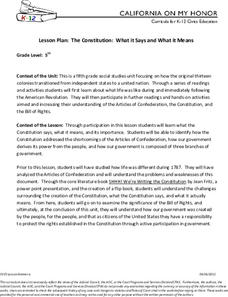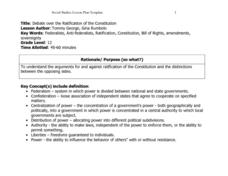Constitutional Rights Foundation
If Men Were Angels: Teaching the Constitution With the Federalist Papers
Much like the methods of group work, the writers of the Federalist Papers worked together to advocate for their viewpoints against the anti-federalists. The resource enables learners to break into small groups and conduct research before...
Center for History Education
The Founding Fathers and the Constitutional Struggle Over Centralized Power
Believe it or not, the Constitution was America's second attempt at a democratic government. Academics travel back to the past to explore the shortcomings of the Articles of Confederation that would eventually lead to the Constitutional...
National Endowment for the Humanities
Ratifying the Constitution
Ratifying the Constitution was no simple task. Using primary sources, such as classic writings from the Federalists and Anti-Federalists, young scholars examine the arguments for and against the Constitution. They then decide: Would they...
Judicial Branch of California
The Constitution: What It Says and What It Means
Learners get the chance to act as representatives to the Constitution Convention, and must decide whether or not to recommend your state ratify the new framework. After examining the Constitution line-by-line, they consider their...
Reading Through History
Anti-Federalist Paper No. 3
Who were the Anti-Federalists and what do primary sources tell young historians about their beliefs? Learners read Paper No. 3 to understand their values in relation to government, such as their discussion on foreign policy and the pros...
Reading Through History
The Federalist Papers: Federalist Paper No. 51
How did Federalists feel about the federal government? Learners search for the answers in the Federalist Paper No. 51, which discusses the powers of the presidency. Then, they answer various questions to test for their comprehension of...
Reading Through History
The Federalist Papers: Federalist Paper No. 10
James Madison, under the pen name “Publius,” justifies the need for an American Republic in Federalist Paper 10, which is perhaps one of the most influential contributions to the Federalist Papers. Readers examine his perspective with...
Judicial Learning Center
The Federalist Papers and The Federal Judiciary
Pupils work in groups or as individuals to read about and then discuss the Federalist Papers. To finish, they write essays about an assigned topic dealing with the Federalist Papers and the federal judiciary.
National Endowment for the Humanities
Chief Executives Compared: The Federalist Papers
Delve into the responsibilities of the president by looking at President Hamilton's opinion of the presidential office in his own words. The second in a three-part series, the resource also offers an interesting compare-and-contrast...
Curated OER
Debate over the Ratification of the Constitution
Twelfth graders discuss the creation of the United States, the Articles of Confederation and the Constitution. Through a class debate, role-playing Federalists and Anti-federalists, they identify the reasons for and against ratification...
National Endowment for the Humanities
Background on the Patriot Attitude toward the Monarch
Learners explain the Patriot attitude toward the British monarchy, which helps them embrace the Founders' reluctance to have a strong executive under the Articles of Confederation as well as their desire to build in checks of executive...
Curated OER
Constitutional Scavenger Hunt
Have your class learn through exploration. They use their texts and go on a US Constitutional scavenger hunt. Included are 45 questions they must hunt to find answers to. This plan uses the text as the main resource, why not give clues...
Curated OER
Ratifying the Constitution
After a lecture on ratifying the Constitution, this worksheet would be perfect to reinforce your government (or U.S. History) students' new knowledge. The activity contains ten knowledge-level and comprehension-level questions. This...
Curated OER
Federalist 47
Students will analyze and evaluate political propaganda. In this lesson on the Federalist movement, students will examine the Federalist papers and analyze the Anti-Federalist argument mage against constitutional ratification. This...
Curated OER
Congress and the Creation of the Bill of Rights
Students participate in inquiry activities to explore powers outlined in the Bill of Rights. In this Bill of Rights lesson, students creation of a class Bill of Rights, evaluate and propose amendments, and analyze primary source...
Curated OER
We the People Lesson 2
Learners compare the Federalists and Anti-Federalists visions for the U.S. government. In this government instructional activity, students conduct research on Federalists and Anti-Federalists figures. Learners use their findings to help...
Curated OER
Why a Bill of Rights? What Impact Does it Have?
Students explore the Bill of Rights. In this Bill of Rights lesson, students compare the Federalist view of government to the Anti-Federalist view of government. Students consider the impact of the bill of rights as they take notes on...
Curated OER
Explore the Constitution
Students examine the U.S. Constitution. In this American history instructional activity, students explore the founders' vision of U.S. government as they participate in readers' theatre, role-playing scenarios, and constitutional...
US Government Publishing Office
U.s. Government Publishing Office: Core Documents of u.s.democracy
Direct online access to the basic Federal Government documents that define our democratic society, a core group of current and historical Government publications.
Gilder Lehrman Institute of American History
Gilder Lehrman Institute: Age of Jefferson and Madison
[Free Registration/Login Required] After a brief description of Thomas Jefferson's and James Madison's contributions to the early ideology and government of the new United States in their authorship of the Declaration of Independence and...
PBS
Pbs Learning Media: Alexander Hamilton: Lawyer, Writer, and Founding Father
Through a short video and an analysis of two primary sources, students will examine the life of Alexander Hamilton, an important military and political leader.





















